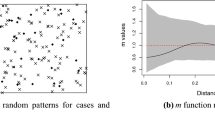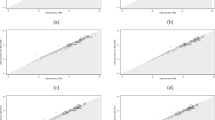Abstract
New theoretical work in urban economics suggests that urban population density contours are inherently discontinuous. This result calls into question the standard practice of estimating smooth density contours and indicates a need for an estimation technique capable of capturing discontinuities. This paper employs such a technique by applying Quandt's switching regression method to the estimation problem. Density contours with marked discontinuities emerge from the empirical work.
Similar content being viewed by others
References
Akaike, H. 1973. Information theory and the extension of the maximum likelihood principle. In2nd international symposium on information theory, eds. B. N. Petrov and F. Csaki. Budapest: Akailseoniai-Kiudo.
Akaike, H. 1977. On entropy maximization principle. InApplications of Statistics, ed. P. R. Krishnaiah. Amsterdam: North-Holland.
Anas, Alex. 1978. Dynamics of urban residential growth.Journal of Urban Economics 5: 66–87.
Anderson, J. E. 1982. Cubic spline urban density functions.Journal of Urban Economics 12: 155–167.
Brueckner, J. K. 1980. A vintage model of urban growth.Journal of Urban Economics 8: 389–402.
Brueckner, J. K. 1981. Testing a vintage model of urban growth.Journal of Regional Science 21: 23–35.
Brueckner, J. K. 1982. A note on sufficient conditions for negative exponential population density functions.Journal of Regional Science 22: 353–359.
Brueckner, J. K. and von Rabenau, B. 1981. Dynamics of land-use for a closed city.Regional Science and Urban Economics 11: 1–17.
Clark, C. 1951. Urban population densities.Journal of the Royal Statistical Society (Series A) 114: 490–496.
Glickman, N. J. and Oguri, Y. 1978. Modeling the urban land market: the case of Japan.Journal of Urban Economics 6: 505–525.
Hannan, E. J. and Quinn, B. J. 1979. The determination of the order of an autoregression.Journal of the Royal Statistical Society (Series B) 41: 190–195.
Kau, J. B. and Lee, C. F. 1976. Functional form, density gradient, and the price elasticity of demand for housing.Urban Studies 13: 193–200.
Kau, J. B., Lee, C. F. and Chen, R. C. 1983. Structural shifts in urban population density gradients: an empirical investigation.Journal of Urban Economics 13: 364–376.
McDonald, J. F. and Bowman, H. W. 1976. Some tests of alternative population density functions.Journal of Urban Economics 3: 242–252.
Mills, E. S. 1970. Urban density functions.Urban Studies 7: 5–20.
Mills, E. S. 1972.Urban economics. Glenview, Ill.: Scott Foresman.
Muth, R. F. 1969.Cities and housing. Chicago: University of Chicago Press.
Quandt, R. 1958. The estimation of the parameters of a linear regression system obeying two regimes.Journal of the American Statistical Association 53: 873–880.
Rissanen, J. 1978. Modeling by shortest data description.Automatica 14: 465–471.
Wheaton, W. C. 1982. Urban residential growth under perfect foresight.Journal of Urban Economics 12: 1–21.
Author information
Authors and Affiliations
Rights and permissions
About this article
Cite this article
Brueckner, J. A switching regression analysis of urban population densities: Preliminary results. Papers of the Regional Science Association 56, 71–87 (1985). https://doi.org/10.1007/BF01887904
Issue Date:
DOI: https://doi.org/10.1007/BF01887904




